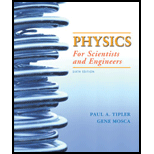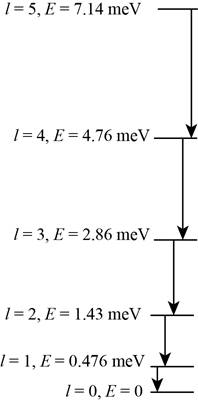
(a)
The moment of inertia and rotation energy.
(a)
Answer to Problem 31P
The moment of inertia is
Explanation of Solution
Given:
The equilibrium separation is
Formula used:
The expression for moment of inertia is given by,
The expression for rotational energy is given by,
Calculation:
The moment of inertiais calculated as,
The rotational energy is calculated as,
Conclusion:
Therefore, the moment of inertia is
(b)
The energy level diagram.
(b)
Answer to Problem 31P
The energy level diagram is shown in figure 1.
Explanation of Solution
Calculation:
The energy level diagram for the rotational level from

Figure 1
Conclusion:
Therefore, the energy level diagram is shown in figure 1.
(c)
The wavelength for each transition of part (b).
(c)
Answer to Problem 31P
The wavelengths for each transition from start are
Explanation of Solution
Formula used:
The expression for wavelength is given by,
Calculation:
The first wavelength is calculated as,
The second wavelength is calculated as,
The third wavelength is calculated as,
The fourth wavelength is calculated as,
The fifth wavelength is calculated as,
Conclusion:
Therefore, the wavelengths for each transition from start are
Want to see more full solutions like this?
Chapter 37 Solutions
Physics For Scientists And Engineers
- Consider the HCl molecule, which consists of a hydrogen atom of mass 1 u bound to a chlorine atom of mass 35 u. The equilibrium separation between the atoms is 0.128 nm, and it requires 0.15 eV of work to increase or decrease this separation by 0.01 nm. (a) Calculate the four lowest rotational energies (in eV) that are possible, assuming the molecule rotates rigidly. (b) Find the molecules spring constant and its classical frequency of vibration. (Hint: Recall that U=12Kx2.) (c) Find the two lowest vibrational energies and the classical amplitude of oscillation corresponding to each of these energies. (d) Determine the longest wavelength radiation that the molecule can emit in a pure rotational transition and in a pure vibrational transition.arrow_forwardAlthough an ordinary H2 molecule consists of two identical atoms, this is not the case for the molecule HD, with one atom of deuterium (Le., heavy hydrogen, 2H). Because of its small moment of inertia, the HD molecule has a relatively large value of E: 0.0057 eV. At approximately what temperature would you expect the rotational heat capacity of a gas of HD molecules to "freeze out," that is, to fall significantly below the constant value predicted by the equipartition theorem?arrow_forwardFor a certain diatomic molecule, the lowest-energy photon in the vibrational spectrum is 0.17 eV.What is the energy of a photon emitted in a transition from the 5th exited vibrational energy level to the 2nd exited vibrational energy level, assuming no change in the rotational energy?arrow_forward
- What is the probability that, at a temperature of T = 300 K, an electron will jump across the energy gap Eg (= 5.5 eV) in a diamond that has a mass equal to the mass of Earth? Use the molar mass of carbon in Appendix F; assume that in diamond there is one valence electron per carbon atom.arrow_forwardTo determine the equilibrium separation of the atoms in the HCl molecule, you measure the rotational spectrum of HCl. You find that the spectrum contains these wavelengths (among others): 60.4 mm, 69.0 mm, 80.4 mm, 96.4 mm, and 120.4 mm. (a) Use your measured wavelengths to find the moment of inertia of the HCl molecule about an axis through the center of mass and perpendicular to the line joining the two nuclei. (b) The value of l changes by +-1 in rotational transitions. What value of l for the upper level of the transition gives rise to each of these wavelengths? (c) Use your result of part (a) to calculate the equilibrium separation of the atoms in the HCl molecule. The mass of a chlorine atom is 5.81 * 10-26 kg, and the mass of a hydrogen atom is 1.67 * 10-27 kg. (d) What is the longest-wavelength line in the rotational spectrum of HCl?arrow_forwardIn a silicon lattice, where should you look if you want to find (a) a conduction electron, (b) a valence electron, and (c) an electron associated with the 2p subshell of the isolated silicon atom?arrow_forward
- Let's consider the three atoms composing the molecule now have different masses and coordinate, while the axis of rotation is still z axis that is perpendicular to the xy plane. The first atom has a mass of 142.54 kg, with x coordinate at 3 m and y coordinate at 6 m. The second atom has a mass of 82.55 kg, with x coordinate at 1 m and y coordinate at 6 m. The third atom has a mass of 8 kg, with x coordinate at 5 m and y coordinate at 9 m. What is the moment of inertia in unit of kg m2 with respect to the x axis?arrow_forwardFind the number of vibrational degrees of freedom of a CO2 molecule,if the average kinetic energy of it is 4 kT.arrow_forwardConsider the NaCl molecule, for which the rotational inertia is 1.30x 10-45 kg*m2. If infrared radiation with wavelength 30 μ m is Raman-scattered from a free NaCl molecule, what are the allowed wavelengths of the scattered radiation?arrow_forward
- The vibrational frequency n for Br2 is 323 cm-1 and the energy difference between its two lowest rotational energy levels, J = 0 and J = 1, is 0.164 cm-1. Calculate the relative populations of the v = 1 and v = 0 vibrational energylevels and the relative populations of the two lowest rotational energy levels for Br2 at 300 K. Comment on your results.arrow_forward2(6) Calculate the fundamental vibrational wavenumber (in cm-1) for HI molecule, if its angular vibrational frequency is 4.394×1014 s-1. Calculate the vibrational energy of the molecule in the ground state and the force constant. Assume the mass is the mass of a proton.arrow_forwardFor silicon at T = 300 K with donor density N_D = 1 * 10^9 cm^{-3} and acceptor density N_A = 0, calculate the equilibrium hole concentration in cm^{-3}. Values within 5% error will be considered correct.arrow_forward
 Physics for Scientists and Engineers with Modern ...PhysicsISBN:9781337553292Author:Raymond A. Serway, John W. JewettPublisher:Cengage Learning
Physics for Scientists and Engineers with Modern ...PhysicsISBN:9781337553292Author:Raymond A. Serway, John W. JewettPublisher:Cengage Learning Modern PhysicsPhysicsISBN:9781111794378Author:Raymond A. Serway, Clement J. Moses, Curt A. MoyerPublisher:Cengage Learning
Modern PhysicsPhysicsISBN:9781111794378Author:Raymond A. Serway, Clement J. Moses, Curt A. MoyerPublisher:Cengage Learning

